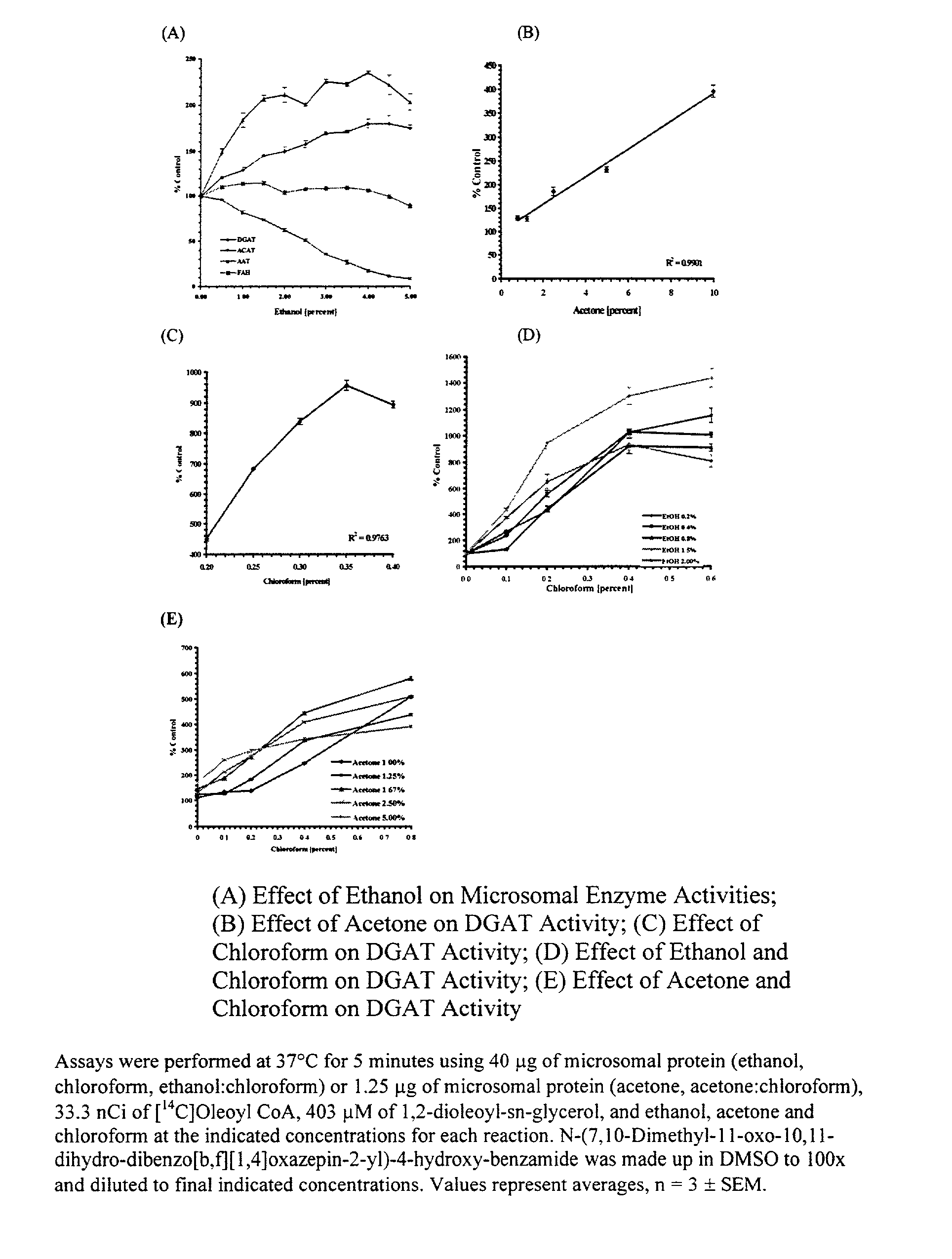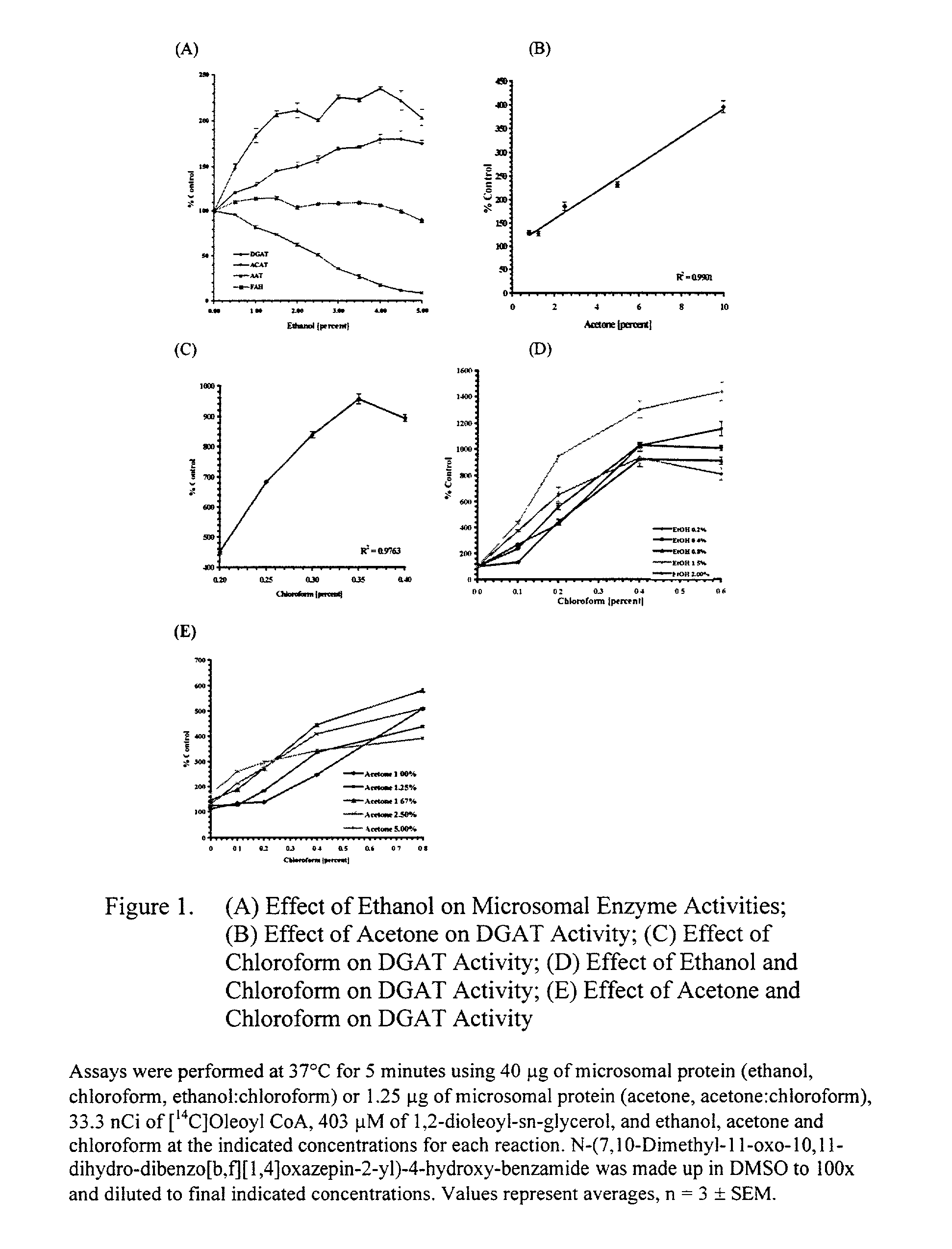Diacylglycerol acyltransferase (DGAT) assay
a technology of diacylglycerol acyltransferase and diacylglycerol, which is applied in the field of measuring the biological activity of diacylglycerol acyltransferase (dgat), can solve the problems of contaminated, low activity of conventional dgat assays, and possible increase in hdl, so as to reduce the activity of related or interfering compounds.
- Summary
- Abstract
- Description
- Claims
- Application Information
AI Technical Summary
Benefits of technology
Problems solved by technology
Method used
Image
Examples
example 1
[0081] DAG Solvents
[0082] DGAT activity was measured using increasing amounts of these DAG solvents: ethanol, acetone, chloroform, and combinations of ethanol:chloroform or acetone:chloroform, where the acetone and ethanol concentrations were held constant while the chloroform concentrations were increased. DGAT activity increases with increasing concentrations of ethanol, R.sup.2=0.9626, with a significant increase of 121% above control at 0.5% ethanol, p=0.013, to a level of 180% above controls at 4.0% ethanol, p=0.005 (FIG. 1A). DGAT activity also increases with increasing acetone concentrations, R.sup.2=0.9901, to a level of 394% above controls at 10.0% acetone, p=0.0006 (FIG. 1B). DGAT activity increases with increasing concentrations of chloroform, R.sup.2=0.9763, to a level of 955% of control at 0.35% chloroform, p=0.0004 (FIG. 1C). When using the combination of ethanol:chloroform, keeping ethanol at 1.5%, DGAT activity increases with increasing concentrations of chloroform, ...
example 2
[0086] Comparison of the DAG Solvents Ethanol and Acetone:Chloroform (8:2) Using TLC and 1-Step Extraction Methods
[0087] ACAT, EAT, FAH, and DGAT are active in the presence of 0.8% ethanol (FIG. 3A). When using the 1 -step extraction protocol, the products of ACAT, cholesterol esters, and EAT, ethyl acyl esters, along with the triglycerides from DGAT are extracted (FIG. 3C). Using 2.1% acetone:chloroform (8:2) eliminates the products from ACAT and EAT and greatly reduces the activity of FAH, thereby increasing substrate availability for DGAT (FIG. 3C). Using 2.1% acetone:chloroform (8:2) in combination with the 1-step extraction method allows for the specific production and extraction of the [.sup.14C]labeled triglycerides produced by DGAT (FIG. 3D). The IC.sub.50 of the reference compound for DGAT inhibition, N-(7,10-dimethyl-11-oxo-10,11-dihydro-dibenzo[b,f][1,4]oxazep- in-2-yl)-4-hydroxy-benzamide, ranges from 2.6 .mu.M for the DGAT assay run with 0.8% ethanol and TLC, 2.4 .mu.M ...
example 3
[0088] Effect of N-(7,10-Dimethyl-11-oxo-10,11-dihydro-dibenzo[b,f][1,4] oxazepin-2-yl)-4-hydroxy-benzamide on DGAT Activity from Four Separate Rat Liver Microbe Preparations Comparing TLC, 1-Step Extraction / TLC and 1-Step Extraction / Scintillation Methods
[0089] Four separate rat liver microbe preparations were used in a DGAT assay to compare the TLC and 1-step extraction methods, as well as comparing the phosphorimager and scintillation methods for detecting [.sup.14C]triglyceride while using N-(7,10-dimethyl-11-oxo-10,11-dihydro-- dibenzo[b,f][1,4]oxazepin-2-yl)-4-hydroxy-benzamide. The IC.sub.50 for Groups 1, 2, 3, and 4 changed only marginally between the TLC method alone, the 1-step extraction / TLC, and the 1-step extraction / scintillation methods (FIG. 4 and Table 2).
PUM
 Login to View More
Login to View More Abstract
Description
Claims
Application Information
 Login to View More
Login to View More - R&D
- Intellectual Property
- Life Sciences
- Materials
- Tech Scout
- Unparalleled Data Quality
- Higher Quality Content
- 60% Fewer Hallucinations
Browse by: Latest US Patents, China's latest patents, Technical Efficacy Thesaurus, Application Domain, Technology Topic, Popular Technical Reports.
© 2025 PatSnap. All rights reserved.Legal|Privacy policy|Modern Slavery Act Transparency Statement|Sitemap|About US| Contact US: help@patsnap.com



